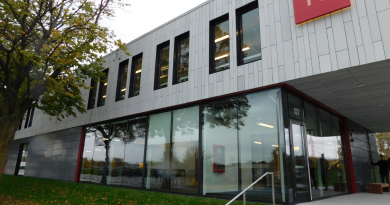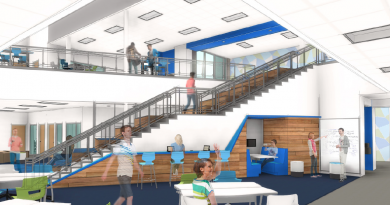High School Stadium Design in a New Era: Community Expectations & Well-Being
By Mark Vander Voort and Thomas Gunnell
The lore of “Friday Night Lights” has inspired community gatherings for generations across the state of Texas. These end-of-week events and the settings that host them form indelible impressions in young minds. School districts and their constituents understand their shared meaning and positive impact.
In consideration of a vision for their own future, Katy ISD engaged HKS, Inc. to help develop a new venue respecting tradition while responding to current needs and expectations. Invoking both history and prophecy, the owner/design team recognized the importance of maximizing the participant and spectator experience while balancing the responsibility of community safety.
The new 12,000 seat stadium at Katy ISD enhances the legacy and identity of its sports heritage and creates a powerful new image for the entire community. More than just an inert building, the stadium positions itself as an artful venue which symbolizes important family events and forms the backdrop for lifelong memories.
It presides over a master-planned 100-acre complex that includes the storied 10,000 seat Rhodes Stadium, its predecessor made counterpart. Both facilities will work in tandem to support eight district high schools and their feeder zones, serving upwards of 20,000 fans efficiently, effectively and safely.
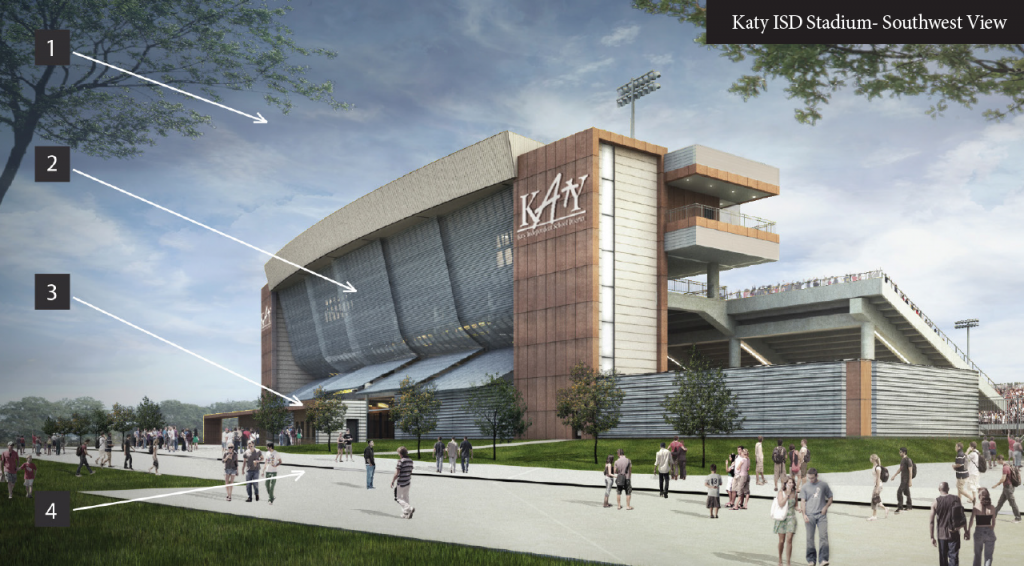

The number of 6A schools make it a necessity to hold more than one event at a time. The decision to locate stadiums in close proximity was driven in part by the large amount of manpower needed to conduct events. The close proximity allows for a more efficient use of resources. For example, the police department can control the traffic for both events with only one complement of police, quick access to refrigerated or frozen concession items and on-site maintenance staff availability. To support this synergy the design of the new stadium includes areas for police with a holding area, extra refrigeration capacity and a maintenance annex for grounds crews or electricians.
As a model district with perennial contenders, Katy aspired to design and construct an exemplary multipurpose facility. Throughout a lengthy stakeholder planning process facilitated by HKS, design committees focused on key guidelines that framed all decisions – venue performance, fan experience, community identity.
Venue Performance is comprised mainly of technical requirements and provisions that contribute to the baseline of patron expectations – sports lighting levels, sightlines, sound and video systems, turf systems, operational efficiencies and maintainability. KISD has engaged each of these issues at a superior level.
Fan Experience moves beyond the baseline and involves the unique sense of enjoyment and delight the park can deliver. Positive experiences are related to ease of use, services provided, comfort, accommodation and well-being. Memorable experiences are framed by intangibles such as a sense of intimacy, connectivity and heightened drama.
Community Identity is enhanced through iconic representations, symbolic gestures and the overall “sense of place” that embody the values and the spirit of Katy ISD schools and families. At Katy, the Home and Visitor stands will glow like beacons at night with team colored LED lighting.
From the beginning, the district recognized its opportunity and responsibility to integrate safety and security into the resulting design. This would be done without compromising the celebratory aspects of the venue described above. Facility planning would also be done parallel to, and integrated with operational planning in order to maximize community accommodation and protection.
Katy ISD and HKS realized they had a golden opportunity to potentially design out many of the potential hazards proactively as opposed to finding ways to mitigate them after construction. In fact, from its inception, Katy ISD plans for this stadium project to be the first interscholastic level sports venue of any type to pursue the benchmark Sport Event Security Aware (SESA) designation from the National Center for Spectator Sports Safety & Security (NCS4). As part of its mission to conduct innovative research, deliver quality training and enhance professional development, NCS4 has assumed the national lead in educating owners/managers to better anticipate and improve crisis response associated with stadium management and operating large events.
Among other criteria, the SESA designation means that whenever possible, facility design and operations planning happen together – in the same place, by the same people, at the same time. This proactive, integrated process ensures greater security efficiency and effectiveness on Game Day. In concert with NCS4, Katy ISD has recognized the various threats that can affect large crowds assembled for stadium events. In today’s world, they can range from weather incidents, to power outages, to fan misbehavior, to terrorist activities. Along with FEMA, CPTED and the EPA, NCS4 has published various guidelines for site and building design. These include a system to anticipate crowd scenarios, possible threats, and mitigation efforts to deter unintended outcomes.
For this facility, KISD formed stakeholder committees that included traditional users, emergency management and law enforcement representatives – city, county, and internal. In keeping with NCS4 recommendations, operations and design issues were reviewed and developed in parallel. The operating procedures and associated training are envisioned as essential elements of the stadium complex.
The large assembly nature of these facilities presents design challenges and opportunities when balancing potential capabilities and vulnerabilities. From traffic guidance, to crowd management, to patron supervision and emergency response, the new stadium at Katy ISD has employed subtle solutions to enhance security performance. Without compromising performance or experiential delights of the venue, the following security concepts were implemented in the layout and design.
As a guest family first arrives, they will already have information about how to approach and where to park from information received on-line, which is most likely where they purchased their tickets. They will quickly realize the site has been organized to ease traffic congestion and facilitate orderly ingress to and egress from the entire area. By loading rows of parking spaces parallel to pedestrian travel, vehicular conflicts are minimized. Also, design to foil high speed vehicular approach to pedestrian areas was addressed.
Completely separate traffic loops immediately surrounding the stadium are dedicated to bus, emergency vehicle and VIP access. They form a secure buffer, which enhances the stand-off approach and distance from the property perimeter. Just before and after game time, they also become a pleasant pedestrian way, giving easy access to main entries. There is also a Parent Loop – a separate drop-off and pick-up area that serve both stadiums without mixing that traffic with parking. This loop actually doubles as a quick exit route for an ambulance heading directly toward the nearby medical center.
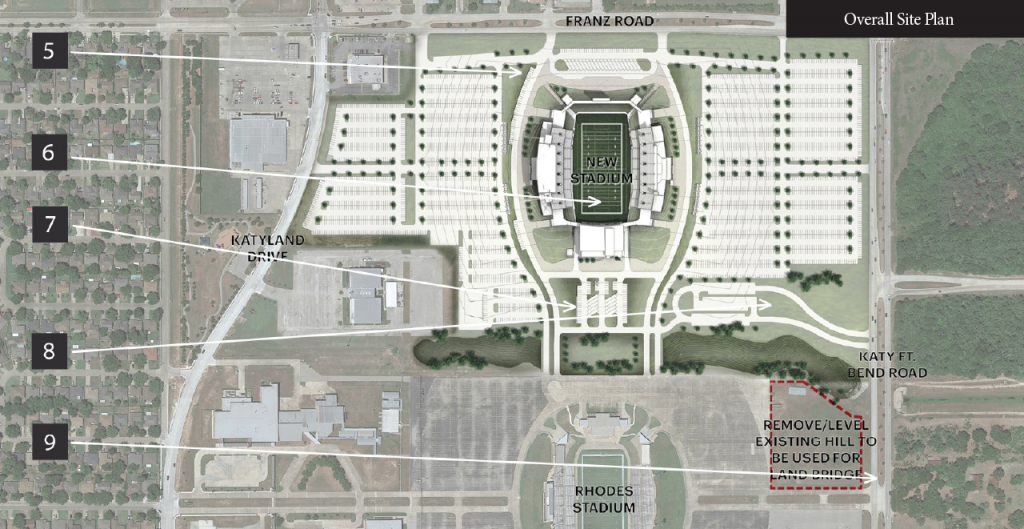

Without requiring significant stairways, or extensive ramps, the entire stadium structure is elevated several feet above the surrounding grade. This provides excellent visibility and parking lot supervision from home and visitor entries, which are centrally located on the west and east sides. The main entries are purposefully consolidated, and not distributed, to maximize bag-check efficiency and effectiveness using minimum staff. A walkway which loops the entire interior of the stadium allows security and staff quick and easy access to any part of the stadium and can be used to move inventory among concession stands.
Once inside, the sweeping concourses have an open view to the field. Again, visibility enhances crowd supervision, creates a strong connection to the arena, and mitigates opportunities for loitering. A proper number of restroom and concession stations are provided to minimize wait times, and further enhance accommodation. Concessions are operated by district food service personnel to improve food safety and control. Themed graphics are employed to enliven school spirit, to document school history and to acknowledge community sponsors.
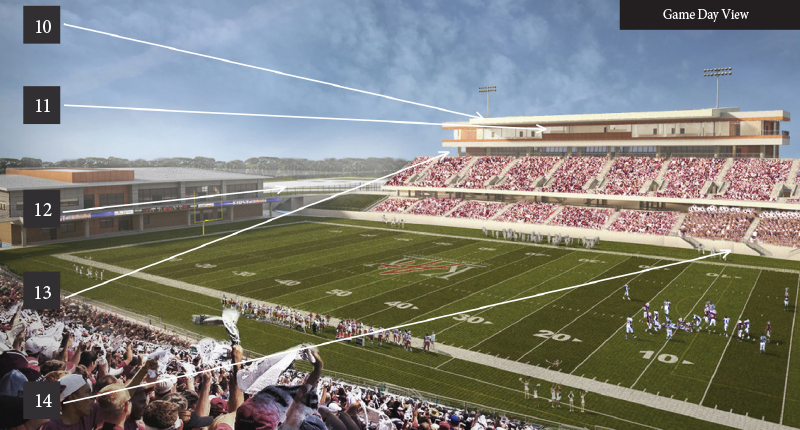

In fact, this venue has garnered the most significant naming right revenues for any facility of its kind. Under the sloping underside of the upper decks, the concourses are enclosed by large perforated metal screens, which provide shelter-in-place to protect fans from dangerous weather events or other emergencies that may arise. At night, these metal screens are designed to glow like beacons beaming bright LED school colors.
On the playfield itself, additional end zone and sideline clearance prevents athlete injuries. And to deter unauthorized admittance, there is no easy access provided from the stands, except at band seating areas. Sports lighting is equivalent to NCAA recommendations, including post-season games that warrant excellent TV coverage.
The Fieldhouse Building at the south end-zone area offers a flexible-use Community Room on its second floor that will be available for special events on Game Day, as well as for professional development and other meeting activities throughout the school year. Along with a dedicated security command booth in the press box, this room will provide opportunity for an adjunct visibility and command center in time of an emergency.
For access to the press box and upper seating levels, there are dual elevators on the home side. Backed by an emergency generator which supports all critical systems, this is part of redundancy approach that anticipates potential malfunctions. The elevators also serve a mezzanine level that allows elder patrons to get to their seats without having to climb from the lower deck. Within the press box, a dedicated command center provides a central point of observation, supervision and communication to all operators and/or attendees in the event of crisis.
Overall, the stadium is sleek, contemporary and straightforward. It exudes a sense of quality. Sightlines are excellent. The rake of the upper bowl even bends slightly toward the field for better viewing angles. The single-story press box has a commanding presence with its cantilevering roof form providing shade to the home stands in late afternoon. The game day experience is inspired from arrival to departure, including from the perspective of both patrons, and performers themselves.


Between the two stadiums, the design team created an outdoor plaza for community events that may take place outside the seating bowls. The plaza and adjacent park-like space are actually a “land-bridge” formed to connect across a major drainage easement previously dividing the site. As part of the master plan for the site, this unforeseen amenity will be well-utilized, and also links the two facilities for ease of shared services, security and connectivity. Even when both are in use simultaneously, they will act AS ONE.
These are a sampling of planning ideas that represent the new age. With regard to safety and security, the safety/operations plan is a living document. As required by NCS4 SESA certification, it is just as important to maintain the plan as to create one in the first place.
Designing for safe, positive experiences requires a keen understanding of crowd psychology, behavior and societal well-being. Strategies must be tailored for each venue and school district. They must be flexible and renewable to adapt to future needs. There is no “cookie cutter” plan that will fit all situations. However, an integrated facility planning process, merged with thoughtful operations guidelines can help keep “Friday Night” events safe, secure, well managed, and inspiring for generations to come.\
—————————————–
About Mark Vander Voort
Mark Vander Voort, AIA, LEED AP, is a principal and Education Practice leader at HKS, Inc., where he is passionate about transforming K12 facilities to meet ever-evolving societal needs and expectations. Professionally degreed at Rice University, Mark has guided the design of school projects across Texas for nearly 40 years. Over that time, he has served as school board member as well as chapter/regional leadership positions at A4LE. He has regularly presented and published such topics as “Flexible Space and Place” and “Sensory Perception in Architecture”.
About Tom Gunnell
Tom Gunnell, served as Katy ISD’s Chief Operations Officer. He is a 24-year Navy Surface Warfare Officer and Desert Storm veteran who from 2003-2008 directed the business functions of the Cincinnati Public Schools District and since 2008 Katy ISD. He is responsible for building operations and maintenance, transportation, purchasing, food service, security, facility planning, human resources, and risk management. In 2010, he was awarded the Association of School Business Officials International Pinnacle Award of Excellence, the organization’s highest individual award and in 2013 received the Professional of the Year Award from the National Center for Spectator Sports Safety and Security.


